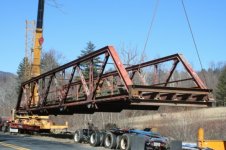Toiyabe
Silver Member
Duration factors are for TIMBER structures only. As you are dealing with a STEEL bridge, please don't be multiplying the dead load by 0.9.

schmism said:he's asking about duration factor.
For a given time a load is on a structure, you can multiply the design values by a factor.
in my world (trusses)
in some cases you have to take a deduction .9DF for permant dead loads.
for wind loads which are assumed to be a load applied to the truss for only an extreamly short period of time, we use 1.6DF
But my world, its all statics. With bridge loads there is a dynamic load you have to account for. Many times youll see a speed limit listed for small bridges for heavy loads, due to the dynamics that the bridge has to support.
Your right that the bridge will likely support more than the 7 tons, but to determine what the safe operational load is, a detailed site inspection will have to be done.
In short, you wont get a "it will support xyz" answer over the internet!